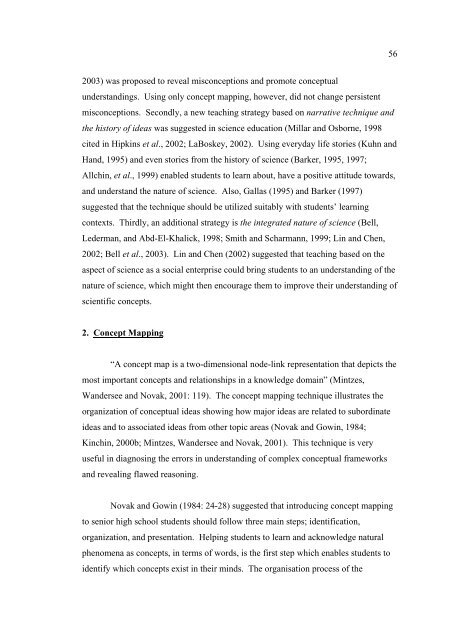an innovative approach
an innovative approach
an innovative approach
Create successful ePaper yourself
Turn your PDF publications into a flip-book with our unique Google optimized e-Paper software.
2003) was proposed to reveal misconceptions <strong>an</strong>d promote conceptual<br />
underst<strong>an</strong>dings. Using only concept mapping, however, did not ch<strong>an</strong>ge persistent<br />
misconceptions. Secondly, a new teaching strategy based on narrative technique <strong>an</strong>d<br />
the history of ideas was suggested in science education (Millar <strong>an</strong>d Osborne, 1998<br />
cited in Hipkins et al., 2002; LaBoskey, 2002). Using everyday life stories (Kuhn <strong>an</strong>d<br />
H<strong>an</strong>d, 1995) <strong>an</strong>d even stories from the history of science (Barker, 1995, 1997;<br />
Allchin, et al., 1999) enabled students to learn about, have a positive attitude towards,<br />
<strong>an</strong>d underst<strong>an</strong>d the nature of science. Also, Gallas (1995) <strong>an</strong>d Barker (1997)<br />
suggested that the technique should be utilized suitably with students’ learning<br />
contexts. Thirdly, <strong>an</strong> additional strategy is the integrated nature of science (Bell,<br />
Lederm<strong>an</strong>, <strong>an</strong>d Abd-El-Khalick, 1998; Smith <strong>an</strong>d Scharm<strong>an</strong>n, 1999; Lin <strong>an</strong>d Chen,<br />
2002; Bell et al., 2003). Lin <strong>an</strong>d Chen (2002) suggested that teaching based on the<br />
aspect of science as a social enterprise could bring students to <strong>an</strong> underst<strong>an</strong>ding of the<br />
nature of science, which might then encourage them to improve their underst<strong>an</strong>ding of<br />
scientific concepts.<br />
2. Concept Mapping<br />
“A concept map is a two-dimensional node-link representation that depicts the<br />
most import<strong>an</strong>t concepts <strong>an</strong>d relationships in a knowledge domain” (Mintzes,<br />
W<strong>an</strong>dersee <strong>an</strong>d Novak, 2001: 119). The concept mapping technique illustrates the<br />
org<strong>an</strong>ization of conceptual ideas showing how major ideas are related to subordinate<br />
ideas <strong>an</strong>d to associated ideas from other topic areas (Novak <strong>an</strong>d Gowin, 1984;<br />
Kinchin, 2000b; Mintzes, W<strong>an</strong>dersee <strong>an</strong>d Novak, 2001). This technique is very<br />
useful in diagnosing the errors in underst<strong>an</strong>ding of complex conceptual frameworks<br />
<strong>an</strong>d revealing flawed reasoning.<br />
Novak <strong>an</strong>d Gowin (1984: 24-28) suggested that introducing concept mapping<br />
to senior high school students should follow three main steps; identification,<br />
org<strong>an</strong>ization, <strong>an</strong>d presentation. Helping students to learn <strong>an</strong>d acknowledge natural<br />
phenomena as concepts, in terms of words, is the first step which enables students to<br />
identify which concepts exist in their minds. The org<strong>an</strong>isation process of the<br />
56
















